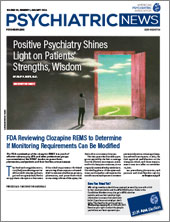When Norma Day-Vines, Ph.D., asked one of her patients about his experiences as a gay, Black man with a strong sense of faith who may not always feel welcome in his church, the patient opened up immediately. “To be honest, that’s something I’m still navigating,” he told her. He eventually explained that maintaining a strong spiritual connection has been helpful to him, as well as relying on friends who share some of his identities.
Day-Vines shared a recorded video of her conversation with this patient at APA’s Mental Health Services Conference as she explained the numerous benefits of broaching racial, ethnic, and cultural differences in psychotherapy. She is a professor of counseling and educational services in the School of Education at Johns Hopkins University and developed the multidimensional model of broaching behaviors.
During the session, Day-Vines was joined by Donna Marie Sudak, M.D., professor and vice chair for education in the Department of Psychiatry at Drexel University College of Medicine, and Mary Beth Cogan, Ed.D., R.N., M.P.H., an assistant professor of psychiatry and behavioral sciences at Johns Hopkins University. In addition to outlining the numerous benefits of broaching, the presenters walked attendees through different aspects of broaching so they can do the same with their own patients.
Open discussion of cultural differences can facilitate the therapeutic alliance, Sudak said. “Broaching is a way of approaching individuals both behaviorally and also with an attitude that creates a safe space for them,” Sudak said, adding that broaching extends an invitation to the patient to open up and signals to patients that the therapist is willing to engage with them and their experiences.
Day-Vines pointed out that many people have difficulties broaching topics related to race, ethnicity, and culture. She also noted that culture refers to the multiple domains that make up an individual’s identity, including gender, sexual orientation, religion, and immigration status, among other factors. She described the continuum of broaching behaviors by the therapist, which include the following:
•
Avoidance: The therapist refuses to raise any topics related to the patient’s racial, ethnic, or cultural concerns.
•
Continuing-incongruent: The therapist makes efforts to broach, but those efforts are awkward and mechanical.
•
Integrated-congruent: The therapist’s efforts to broach are effective, and the therapist can explore issues related to culture in a meaningful and substantive way with the patient.
•
Infusing: This piece of the continuum likely happens outside of the therapeutic relationship. It occurs when the therapist does much of what the integrated-congruent therapist does but also recognizes the socio-political and socio-cultural concerns of patients and works to eliminate any barriers patients face.
The presentation also focused on the importance of teaching residents how to broach. Cogan shared research she did in which she asked second-year psychiatry residents at Johns Hopkins to take the Broaching Attitudes and Behavior Survey, developed by Day-Vines and colleagues. The survey assesses respondents’ attitudes toward having explicit discussions about race, ethnicity, and culture with patients, placing them on the continuum described above.
“Our results were very promising,” Cogan said, noting that most of the residents were not avoidant. “That told us that they were very much open to having conversations about these issues.”
Further, Cogan conducted interviews with residents, during which she spoke with them about what they hoped to learn more about related to broaching. “The residents really felt they needed to know more about history, both their local history and the history of psychiatry and how [these histories are] impacting their patients,” Cogan said. They also wanted to know more about group-specific content, such as the specific needs of their LGBTQ patients or patients from a specific minority group. In their clinical work, they wanted to see a lot of patients and to integrate racial, ethnic, and cultural factors into their clinical rounds.
Sudak noted that during the second year of residency, many residents are working on improving their abilities to relate to patients, rather than focusing solely on gathering information. “Obviously, these are anxiety-provoking conversations for all of us, and when you also want to do a good job and you’re nervous about your performance, the stakes are much higher,” she said. But educating residents specifically about broaching tactics will not only improve their relationship with their patients, but also make them better supervisors later in their careers, she said.
Day-Vines shared a story of working with a student who was a 25-year-old White woman. The student was conducting psychotherapy sessions with a 19-year-old African American patient. Day-Vines urged the student to ask the patient about race; the student was resistant, but eventually did so.
The next semester, the student told her class that broaching the topic of race with the patient was hugely helpful. “She told the class, ‘I realized that I was the one who was uncomfortable having the conversation,’ ” and added that the patient was ready to have the conversation, Day-Vines said. “To me, that was confirmation that helping students have these conversations with patients is really important.” ■

